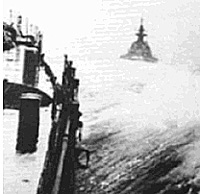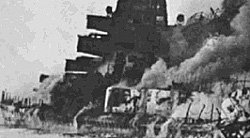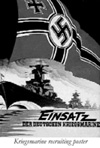This is the second instalment of the “Seekrieg” series, (the first being the “Battle of Britain” in issue #7) a game based on the assumption that the Germans captured the French Fleet intact after the Fall of France in 1940...

With the take over of the French Fleet completed, and plans already in place for the invasion of England, Hitler ordered Grand Admiral Raeder to cripple the British Fleet. The entire Hochseeflötte, under the command of Admiral Günther Lütjens, and the newly organised Deutches Atlanikflötte, commanded by Admiral Schniewind, consisting of the re-commissioned French Fleet, were sent to sea.
Their objective was twofold. First, to cut Britain’s Atlantic supply lines, which could cripple the country, and force Churchill to beg for peace, and second, to draw the British fleet out of Scapa Flow, and their other bases, and force them to chase the German fleet around the Atlantic. This would allow the Germans to attack the British fleet with a possible local advantage, as the Royal Navy would have to spread itself fairly thin in order to intercept the scattered enemy.
The British reaction was to strengthen their patrols and pickets, and to send sorties into both the Atlantic, to combat the raiding groups, and into the North Sea, to intercept German units before they could attempt a br eak out. Units were recalled from the South Atlantic, and it was suggested that part of the Mediterranean Fleet be recalled to join the imminent battle. This plan, put to Churchill and the War Cabinet by the First Lord of the Admiralty, A.V. Alexander, was not adopted after protest from Admiral Sir Dudley Pound, the First Sea Lord, C-in-C of the Royal Navy. Pound was concerned that weakening the British fleet in the Mediterranean might inspire the Italians to attack Malta, and threaten Alexandria and even Gibraltar. His ideas found a friendly ear in PM Churchill, who refused to allow any weakening of the fleet in the Mediterranean.
The Battle is Joined
[In order to allow a game involving very little or no strategic map movement, as we are more interested in a quick, easy to set up series of games than a drawn out plotting session, we have divided all of the available ships into battlegroups, and rolled random encounters for each of the areas of conflict: North Atlantic, North Sea and English Channel. We can then take the action directly to the tabletop, without the need for complex hidden map movement. ]
The following report has been assembled from actual battle repor ts, from both German and British sources, from radio traffic intercepts, and from newspapers and wireless services in Neutral countries. Some of the sources used are censored, but all of the information in this column has been confirmed.

Actions in the North Atlantic, at sometime between October 24, and November 2, 1940
In the early hours of either the 24th or 25th of October 1940, the first action of Operation Atlantikûbung - as it was called by Grand Admiral Raeder - took place. It was an encounter between the U-Boat Tender Eltville, and the British Task Force “G”, (under the command of Rear Admiral A.X. Fortesque, on board HMS Revenge). Details about bothe the incident and the British vessels involved are hazy, as the German vessel was apparently scuttled without sending any radio signal. Task Force “G” is as the Royal Navy’s display of power in the North Atlantic - Brittannia’s guarantee that She still rules the waves.
Later in the same week, one of the brave convoys of merchant ships, so vital to Britain’s survival, was attacked within days of leaving Halifax. The KM Emden, accompanied by the DFS (Deutches Französisch Schiff - German French Ship) Suffren, and the “Narvik Flotilla” destroyer Z-24, inflicted heavy losses on the convoy HX-26, sinking all of their escorts, believed to have been a single cruiser, and two or three obsolete destroyers. The merchant ships were scattered, with many subsequently lost as they fled South, towards the neutral waters of the USA.
The radio reports of the action were recieved by elements of the British South Atlantic Squadron. HMS Ajax and Exeter, and HMNZS Achilles, (all of River Plate fame), were steaming for England, as escort for a large convoy from the West Indies, and changed course in an attempt to intercept the Axis battlegroup. What happened next is not clear, but it appears as though the three ships ran across a U-boat Wolf Pack. All three ships were lost, and no word has been recieved as yet regarding survivors.
Actions in the North Sea, at sometime between October 26, and November 1, 1940
Depite the fact that some of the British pickets had been reinforced as early as October 19th, no major naval incidents took place until the 26th. The battleships HMS Resolution and Royal Sovereign were on manoeuvres when “the balloon went up”, and were last reported East South East of Iceland, in dense fog, en route to the British Naval base of Scapa Flow.
They were unescorted, in what was believed to be “friendly water” (their escorts having been detatched to relieve the Iceland / Faeroe Islands pickets). Contact was made on Radar, and after no reply was recieved to radio challenges, their commanders assumed that the contacts were in fact the enemy.
Opening fire through the swirling fog on their shadowy opponents, the Royal Sovereign immediately scored a hit, a dull flash lighting up the fog. It was to be the last joy for these two great ships. The German cruiser force (KM Admiral Hipper, Köln and the destroyer KM Giese) had been shadowing the Britsh ships for several hours. Only when they accidentally strayed too close did the British discover their presence. The opening salvo from the battleships struck the destroyer, sinking her in minutes, with all hands.
Hipper immediately returned fire, shells striking Royal Sovereign amidships, starting a fire in one of the ready-use AA ammunition lockers, and shattering the delicate tubes of her vital Radar set, leaving her blinded in the dense, wet fog. Shells continued to rain around and on Royal Sovereign as the German gunners found their range. Another 8-inch armour-piercing shell struck the ship, tearing through the deck, and exploding near the after steering compartment, causing extensive damage.
The crippled giant could no longer respond to the helm, and like a punch-drunk boxer, could only wait, stunned, as the heavy shells continued to slam into her. HMS Resolution was not sitting idle during this exchange. She opened fire on Köln, quickly scoring a hit with her 15-inch main armament. A single shell struck the light cruiser, tearing into her deck and starting a fire near her after turrets. Her retur n fire struck Resolution, a High Explosive shell starting a fire just before her conning tower. As damage control parties rushed into action on both vessels, Köln turned away, narrowly avoiding another salvo of British shells. She continued to fire, shells from her quick firing guns raining on the mighty British battleship, ripping into her thick flanks. A lucky hit struck the foretop director tower, and suddenly, both of the British ships were blind, unable to find their attackers, no more than target practice unable to find their attackers, no more than target practice for the eager German gunners.
Admiralty received no further transmissions from either ship.
Nine hours after the last message was received from HMS Resolution and Royal Sovereign, five British destroyers - three L/M class, and two of the more powerful Tribal class - were searching the area where it was believed that they had been attacked. The weather had cleared, as it was now mid-afternoon, and four enemy vessels were sighted, closing from the East.
The four formerly French destroyers were covering the retreat of the KM Admiral Hipper and the damaged Köln. In the confused melee that ensued, amid smokescreens and high speed torpedo runs, two of the British ships, HMS Lightning and Loyal, were sunk, and HMS Lance was so badly damaged that she had to be scuttled half an hour later. DFS L’Intrepide caught fire, burning to the waterline, and Le Temeraire was badly damaged, managing to limp away under covering fire from Mameluck and Lansquenet, both of which made good their escape under smoke. The two Tribal class destroyers, having avoided most of the fray, stopped to pick up survivors from the wreckage of the sinking British ships. A nearby Unterseeboote, which had been watching the action for some time, took the opportunity to close in, and HMS Sikh was struck amidships by three 21-inch torpedoes.
 One of them failed to detonate, but the other two exploded, tearing the hull apart, and scattering debris over a wide area. HMS Ashanti made a desperate rush on the now located submarine, depth charging it, causing severe damage, before being struck herself, by a single torpedo. The explosion tore a gaping hole in her side, and she rolled over and sank within minutes.
One of them failed to detonate, but the other two exploded, tearing the hull apart, and scattering debris over a wide area. HMS Ashanti made a desperate rush on the now located submarine, depth charging it, causing severe damage, before being struck herself, by a single torpedo. The explosion tore a gaping hole in her side, and she rolled over and sank within minutes.
The badly damaged U-boat sailed into Wilhelmshaven days later,missing most of her conning tower. On board were eleven British sailors, survivors from the Ashanti, who would spend the rest of the war in a POW camp. They were the lucky ones.
Actions in the English Channel, at sometime between October 28, and November 2, 1940
With the exception of a few sightings, and intermittent fire from the various coastal batteries, the waters South and South East of England were quiet in the days after the alert was sounded. Minesweepers and minelayers trawled the area, while coastal convoys and fishing boats plied their trade. No breakthrough had been attempted by any German vessels, and no French ships had been hunting in the area. All that changed on the morning of October 28.
Several hours after midnight, a very powerful German destroyer force, consisting of six of the modern “Narvik Flotilla” with their formidable 5.9-inch guns, left Rotterdam, where they had been hidden for the previous two weeks. Their objective was to strike at channel shipping, and to harrass any Royal Navy patrols which they came across, then proceed to the port of Le Havre. Just after dawn, a British coastal patrol, of two small destroyers and two frigates left Portsmouth. They headed East into the foggy channel, following close behind two motor minesweepers.
As the early morning fog cleared, the two opposing patrols met. The action was quick and almost entirely one-sided. All of the British ships were sunk, and the German destroyer Z-30 had to be abandoned, as fire started by several HE hits raged out of control.
The surviving German vessels continued on their way, steaming fast now, to the South West, sure that their presence had now been reported, and that any element of surprise had been lost. The radio reports from the British patrol had been received, and action was swiftly taken. The cruisers HMS Sheffield (armed with twelve 6-inch guns) and Aurora set out at once to intercept the five German ships. As soon as the enemy were sighted, Sheffield’s guns opened a terrific barrage, and within a matter of minutes, two of the fleeing destroyers were sinking. The remainder took violent evasive manoeuvres, and made smoke, in a desperate attempt to throw the British gunners off the mark.
One of the three scored a hit on the Sheffield, silencing one of her forward turrets for some time. As the destroyer turned once more to run for the safety of Le Havre, a shell pierced her sidebelt, setting off one of her magazines, the ship disappearing in a brilliant flash, and a pall of smoke. The surviving destroyers, Z-28 and Z-29, shrouded in smoke, made good their escape. Three days later, a German raiding force, consisting mainly of impounded French vessels, approached the Cornish port of Penzance under the cover of a rainsquall. The reason for the raid was a report received from a source in England, that the battleship HMS Valiant was there, waiting to form a battlegroup with other units expected over the next four days.
 Kriegsmarine recruiting poster
Kriegsmarine recruiting poster
A decision had been taken quickly: an attempt to cripple the battleship in port must take place - the opportunity was too good to be missed. The raiding force was approaching the harbour as the rain cleared. The light cruiser DFS Jean de Vienne opened fire on the shore batteries, as the two destroyers DFS Mogador and Volta, with two German torpedo boats, commenced their run up the harbour.
An unexpected reception awaited the Axis ships, as they came under fire from four British destroyers, of which they had no warning from their spies. One of the fast torpedo boats was sunk, and the Mogador was set afire, and severely damaged in the rapid exchange, which saw three of the British ships sunk in return.
The HMS Valiant was still moored, and building steam, as Mogador and Volta made their charge toward the docks. She had not hit either ship with her 15-inch main guns, and as she slipped from her moorings under her own power (damaging the heavy timbers of the dock in the process), the brave Mogador fired her two remaining torpedoes.
The DFS Volta continued to weave her way closer to the massive battleship, which was turning hard ’a starboard, propellers churning the water to foam. She accelerated away from the dock just in time, as Mogador’s torpedoes sped past her flank.
As Volta turned hard, trying to bring her torpedo tubes to bear on Valiant, the giant unleashed a barrage of fire from her secondary battery. She had completed the tur n, allowing all five of the twin 4.5-inch gun turrets, which lined her port side, to fire on the destroyer.
Massive columns of water were thrown up all around the fragile target, yet somehow the withering hail of shells failed to connect with the Volta. Riddled with shell splinters from the near misses, she managed to unleash a point-blank spread of five torpedoes, directly into the path of the British ship.
Two of the five struck the Valiant just abaft her anti-torpedo bulges, tearing a gaping hole in her belt, below the waterline, causing massive damage to her engines and power plant. As the stern began to flood, and settle lower, a third fish struck near the bow, ripping open her side. As armour plates buckled, and bulkheads gave way, a massive tide of water entered the ship, and she immediately listed heavily to port. The order to abandon ship was given, as the list quickly became a roll, the ship heeling over onto her side, and sinking quickly by the bow.
As the attackers turned to leave, still firing on the sole remaining British destroyer, HMS Eskimo, the guns of one of the shore batteries found their mark. DFS Mogador was struck repeatedly by shells from one of the Quick Firing 5.25-inch mountings. She lost her bridge to a direct hit, and another hit on her fo’c’sle tore off part of her bow, and started another blaze. Soon after, Eskimo also found her range, and the crippled destroyer was soon reduced to a smoking wreck. The DFS Jean de Vienne and Volta, and the torpedo boat KM T-7 made their escape to open waters at high speed, under cover of a smokescreen. HMS Eskimo did not give chase.
 German E-boat in full flight
German E-boat in full flight
These are the reports of the first week of the campaign. So far, things are not looking all together good for the Royal Navy. Will the British Navy be able to turn the tables on the Kriegsmarine? Will the Atlantic be closed to merchant shipping, dooming the United Kingdom to starvation and surrender? Will Gav and I get sick of staring at those blue tablecloths?
Only time will tell...
Losses after the first week stand at:
British Royal Navy:
3 Battleships
1 8-inch Cruiser
3 6-inch Cruisers
13 Destroyers
2 Frigates
63% of Convoy HX-26
German Kriegsmarine:
(Höchseeflötte and Deutches Atlantikflötte)
7 Destroyers
1 Torpedo Boat
1 U-boat Tender
Thoughts from the minds of the players, after one week of intense naval battle:
“After the first week, things look dim for the British forces. Losing two battleships in one encounter was a major blow, but full credit to Chris for the ‘jamminess’ of that result. (Fog plus No Radar equals Not Much Fun.) The performance of the 12-gun cruiser against destroyers gives hope for the future. I must make up for these early losses later in the campaign. The British have often historically demonstrated an ability to snatch victory from the jaws of defeat. Hopefully I can emulate this feat.” Gavin Bowman
“Hmmm... early luck. Hopefully I can whittle down the British forces without suffering too badly myself. Once I do enough damage, I can launch an invasion of England - which is of course my ultimate goal in the campaign. But can luck with dice (and good Admiralship!) last forever? I for one hope that it can, because I’m going to need a whole lot more luck to get through this!”
More Atlantikubung
-
Part 1: “Battle of Britain” (KS7)
Part 2: “Lead up to Operation Seelowe” (KS9)
Part 3: “Continuing Campaign” (KS10)
Back to Table of Contents -- Kriegspieler #9
To Kriegspieler List of Issues
To MagWeb Master Magazine List
© Copyright 2000 by Kriegspieler Publications.
This article appears in MagWeb (Magazine Web) on the Internet World Wide Web.
Other military history articles and gaming articles are available at http://www.magweb.com